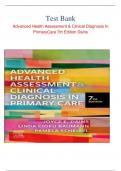Exam (elaborations)
Advanced Health Assessment & Clinical Diagnosis In Primary Care TEST BANK 7th Edition by Dains|| LATEST UPDATE 2024
Advanced Health Assessment & Clinical Diagnosis In Primary Care TEST BANK 7th Edition by Dains|| LATEST UPDATE 2024
[Show more]



